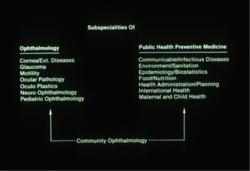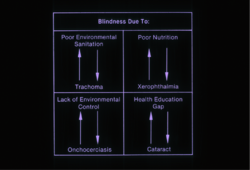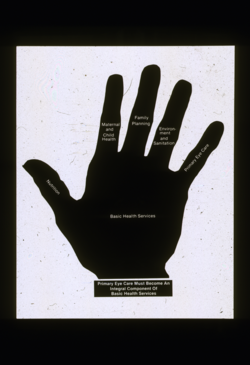Community ophthalmology
Topic: Medicine
 From HandWiki - Reading time: 3 min
From HandWiki - Reading time: 3 min
Community ophthalmology was described as a new discipline in medicine promoting eye health and blindness prevention through programs utilizing methodologies of public health, community medicine and ophthalmology in 1978. This new discipline was first proposed[1] by Dr. Patricia E. Bath in 1978 after observations of epidemics rates of preventable blindness among under-served populations in urban areas in the US as well as under-served populations in so called third-world countries.[2][3]
The failure of hospital-based eye care to provide preventive services for at-risk populations as evidenced by the high rates of blindness due to preventable causes. Moreover, government institutional-based public health facilities were not equipped to prevent or treat the at-risk populations because the system-wide infrastructure lacked personnel capable of delivery of services for eye health education and eye health care.
Historically, public health departments had staff of physicians, epidemiologists, biostatisticians, environmentalists and perhaps microbiologists. The disciplines included in public health services were maternal and child health, nutrition, family planning, and sanitation and environment. Hospital and public health institutions viewed ophthalmology (i.e. eye care services) as tertiary health care to be delivered solely by ophthalmologists. The basic public health services included pediatricians, obstetricians, gynecologists, family practice physicians, environment/sanitation specialists as well as nurses and midwives but no ophthalmic assistants.
In the discipline of community ophthalmology, the new cadre of personnel known as eye health care workers, eye health care educators, or ophthalmic assistants are trained to provide eye care and blindness prevention services at the village or door-to-door level.
For example, in villages with endemic trachoma the eye care health workers would educate families about the importance of sanitation and handwashing and also provide access to eye drops. In areas with high rates of blindness due to cataract this cadre of personnel would educate families about the cure for blindness due to cataracts with eye surgery. Changing the belief that blindness is an inevitable consequence of aging requires community eye health education about curable blindness and preventable blindness which is still so necessary in many parts of the world. Community ophthalmology teachings include the concept of primary eye care which has been advocated as both as a stand-alone health service as well as a new integral component of basic health services or public health services.[4]
This new concept has been shown to be a sight-saving blindness prevention strategy. Since its inception in 1978, programs of community ophthalmology have been developed worldwide. The promulgation of programs of community ophthalmology can be traced through programs of WHO,[5] NGOs like AiPb,[6] and through the effort of individuals such as Professor Cornelius Odarquaye Quarcoopome in Africa [7] and Professor Kirmani in Asia and Professor Bath worldwide.
In 2017 Dr. Bath's role in the founding of community ophthalmology was recognized by Medscape as one of the "14 Women Physicians who Changed the Course of American Medicine."
In 2021 the English National Health Service started a program to allow hospital ophthalmologists to access records, referrals, and diagnostic images from high street optometrists in England. This is intended to cut out test duplication and reduce unnecessary hospital appointments.[8]
References
- ↑ Biography, Patricia E. Bath, NIH
- ↑ Bath PE (May 1978). "Blindness Prevention Through Program in Community Ophthalmology in Developing Countries[yes|permanent dead link|dead link}}]", Excerpta Medica Series 442, Amsterdam, Oxford CCIII International Congress of Ophthalmology, 1913- 1915.
- ↑ Bath, PE (February 1979). "Rationale for a program in community ophthalmology". J Natl Med Assoc 71 (2): 145–8. PMID 423288.
- ↑ Guide Pour Les Programmes De Prevention De Cecile, WHO, 1979
- ↑ Report of the 11th meeting of the WHO Programme Advisory Group on the Prevention of Blindness: WHO PBL /95.51
- ↑ American Institute for the prevention of Blindness (AiPb) www.blindnessprevention.org
- ↑ "Bath PE, Quarcoopome CO, Kirmani: Community Ophthalmology Plan for Underserved Populations. ACTA 24th International Congress of Ophthalmology, 2,13-17,1983". http://www.blindnessprevention.org/index_htm_files/Community%20Ophthalmology%20International.pdf.pdf.
- ↑ "NHS starts digital transformation of high-volume specialty". Health Service Journal. 2 March 2021. https://www.hsj.co.uk/technology-and-innovation/nhs-starts-digital-transformation-of-high-volume-specialty/7029599.article?.
 |
 KSF
KSF


